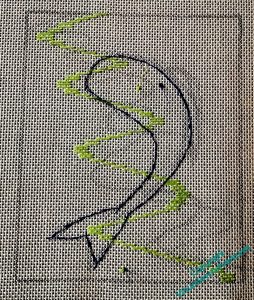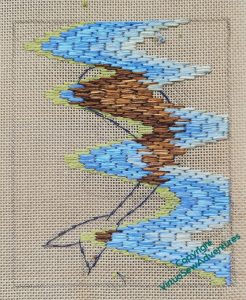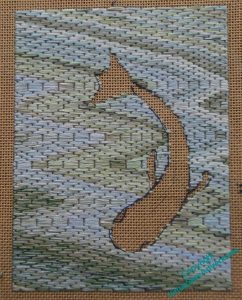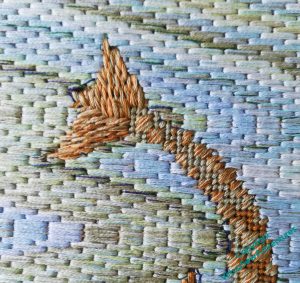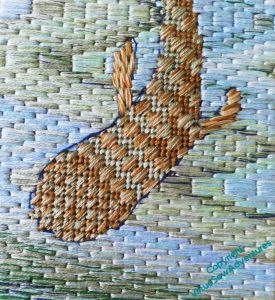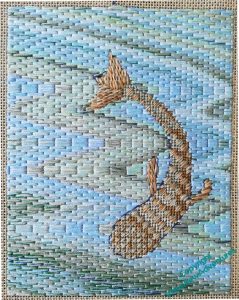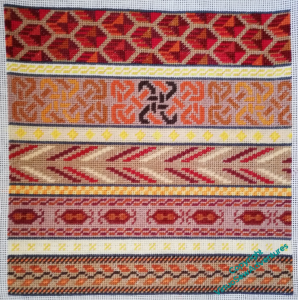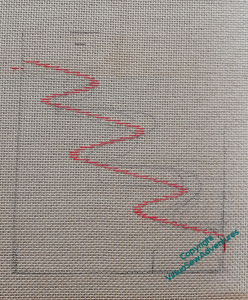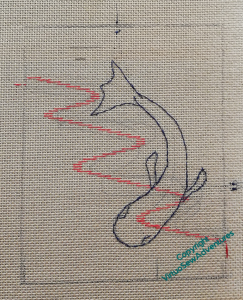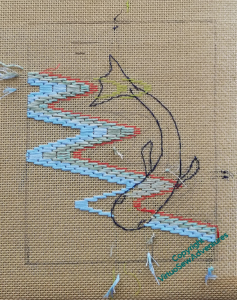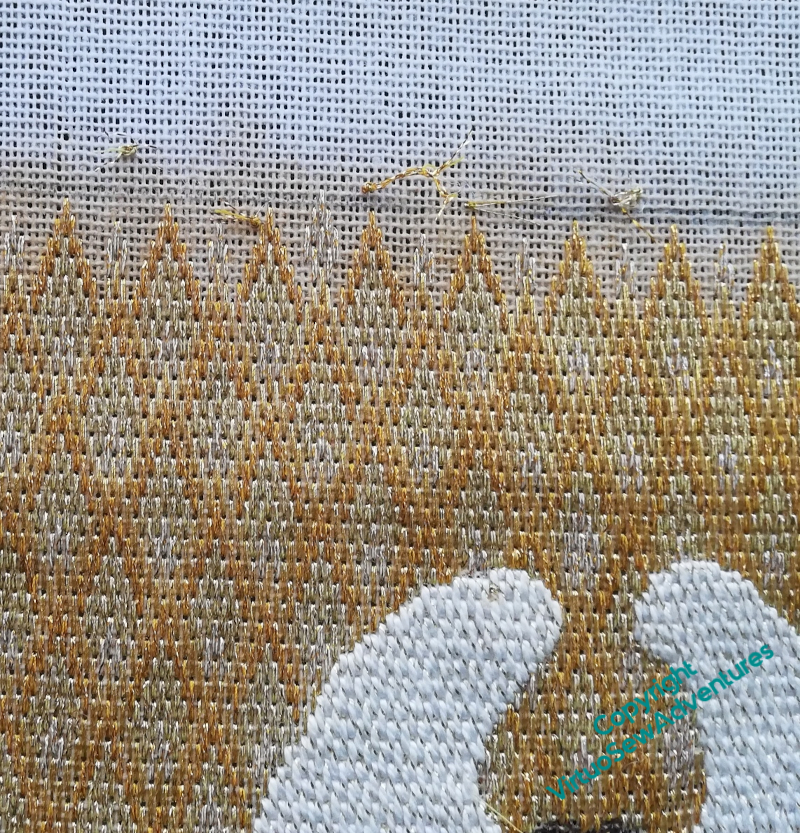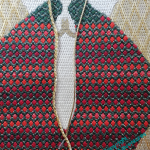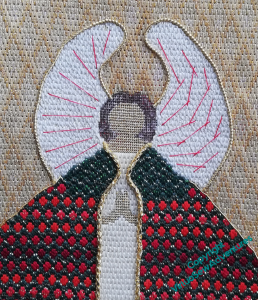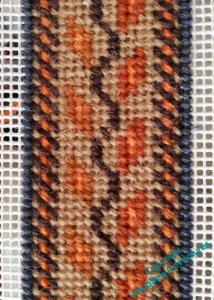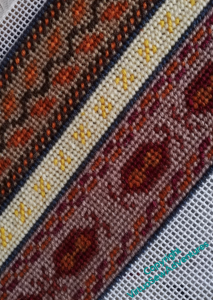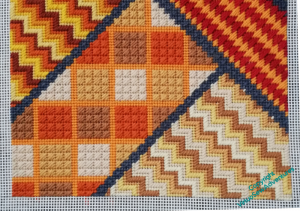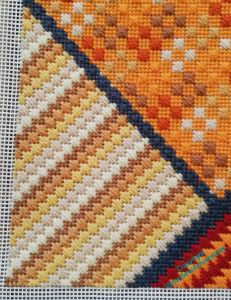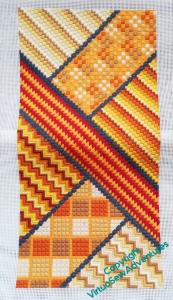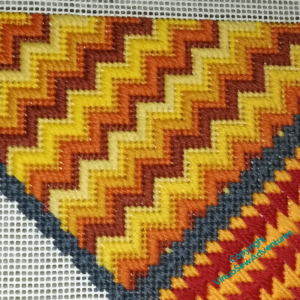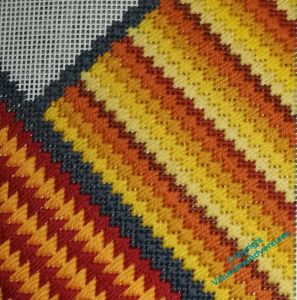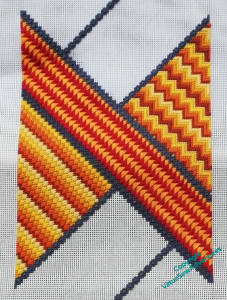Tag: canvaswork
A Second Fishy Experiment
So, having learnt enough to be encouraged by the First Fishy Experiment, I embarked upon my Second Fishy Experiment.
Again, I drew out the borders, tacked the edges of the fish, and drafted the line of the bargello pattern using coloured sewing cotton. You can see how many times I thought and rethought what I was going to do in pencil beforehand!
I’m using the same bit of leftover canvas, so again my threads will be blended using nine strands of stranded cotton, although I’ve added a bit to the fish by using a variegated metallic machine embroidery thread as one of the strands.
This time the experiment is to see whether I can create something of the effect of looking through the surface of water at the fish. That means making the edges of the fish uneven, rather than crisp, so rather than an entirely different set of stitch choices for the fish, and compensation stitches everywhere, I will use the same stitch pattern throughout.
That in turn means that as I approach the edge of the fish on each row, I have a decision to make about whether to use the water colour or the fish colour for the stitch that straddles the edge. Fortunately, this isn’t the sort of decision I find unnerving or difficult to make, and even here, I think you can see that this idea is rather likely to work!
I realise that the post about starting the Second Fishy Experiment somehow managed to end up well behind the videos. Episode 57 of Slow TV Stitchery is now live, in which we muse on the effects of blending colours in the needle, the demise of Scottish pearling, and the final “It depends!” moment.
First Fishie Experiment Finished…
The background of freeform Bargello was rather entertaining to do. Working using nine strands of stranded cotton allowed for some subtlety in the colours, combining various blues and greens in different proportions and shading them into one another, sometimes gradually, sometimes stongly. I was surprised, sometimes, when progressively adding a particular colour, to find that it didn’t make as much difference as I expected – but this is why we experiment!
Once I came to the Fishie himself, there was a bit of puzzlement. I wanted to have a different pattern for the head, the fins and tail, and the body. I wanted a vaguely “scale-like” pattern, and I wanted to make sure that the stitches were at a different orientation to the water.
I settled on Moorish Stitch for the body, Mosaic Stitch for the head, and Encroaching Gobelins Stitch for the fins and tail. And I left in the tacked outlines. They only show in a few places, and I think they give the impression of sketched lines, which is quite suitable for an exploratory piece. I’ve also left out the eyes, since I’m looking from above.
Looking at it now, I’m pleased with the sense of flowing water that the bargello nearly creates, and the fish is interesting, but maybe not entirely successful. Some of the edges and joining points are a little clumsy – but that may be because this is an experiment, thrown together to see what I learn.
I’ve had at least one idea for another fishy experiment, so you will be seeing more of this sort of thing…
And indeed, Episode 54 of SlowTV Stitchery describes the beginning of the Second Fishy Experiment, in which I begin a second fishy experiment, this one attempting to give the impression of the fish seen through water, making some slight changes to the form of the freeform bargello, and anticipating tussles with my very leftoverish leftover thread.
Finishing the Stash Busting Cushion
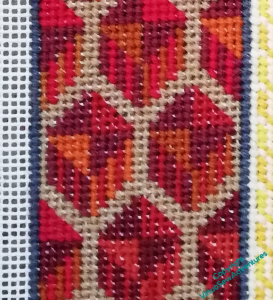
Remember this? Remember how suprised I was at just how much I was enjoying canvaswork?
I found the last pattern in “Victorian Needlepoint” by Freda Parker, another one inherited in a bundle. I keep meaning to have a good rummage in that bookshelf, and work out what I want to keep, but as it is, it makes a good resouce when I’m looking for “something, I don’t know what, but I will know it when I see it”.
Since I’m stash busting, I used several different skein remnants for each colour on the chart, so the pattern has more variety than drawn. There are three shades in the very darkest sections, and I was surprised by how little difference two of them showed once they were stitched. You learn things at the oddest times.
That panel is the last, by the way, because at this point I ran out of canvas!
It does, however, make a squarish, ornamental panel. If I can find some suitable fabric, I can give it a backing and turn it into a cushion.
Episode 52 of SlowTV Stitchery is now live, in which I challenge you all to name some works of fiction in which needlework has a prominent and positive role…
An experiment for Placidus
Bear with me, please!
At the moment, the idea for The Vision of Placidus is that the main picture – the encounter between Placidus and the Christ/Stag – will be framed with a depiction of denizens of the natural world – underwater creatures in the lower section, bulrushes and dragonflies in the upright sections, and birds in the upper section. I’ve been thinking of putting the symbols of the Evangelists in the corners, to obviate the necessity of dealing with getting the design around those corners.
However, what I’ve not yet sorted out is the technique I might choose to use. This is going to be an experiment to see whether using canvaswork – a sort of freeform Bargello with embellishments – will create a pleasing effect.
I was really very pleased with how quickly this came together when I began thinking about it. The red line is a guide for the freeform Bargello, representing the current in a stream, and the fish is simply there to help me test how to deal with the boarders between the flowing background and the motifs.
That might be easiest to achieve if I worked the fish, and then added in the background, but if I do that, I think it will be nearly impossible to place the background correctly on the far side of the fish. So this time, I’m doing the background first, putting in the stitches across the fish in sewing cotton, as a sort of “draft”.
I’m using stranded cotton, separated and combined to create blended shades. As it turns out, six strands are not quite enough for full coverage, so here I am using nine.
Episode 51 of Slow TV Stitcery is now live, including a comparision of bone and steel laying tools, consideration of two possibilities to experiment with for Placidus, and thoughts about taking sagas seriously.
Continuing the stash busting cushion
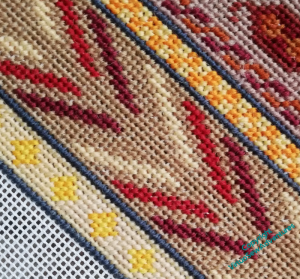
The second, simpler version of the stripes works better – much better. I like the deepening colours, and the change of spacing creates a changing rhythm.
The next band uses three different yellows to make little diamond shapes, alternating darks and lights – although as the darks and lights looked closer togther when stitched than on the hank, the alternations don’t show as much as I thought they would!
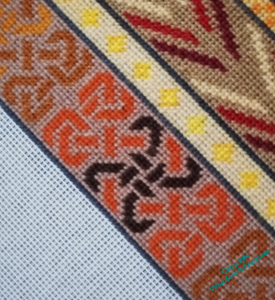
I became a little ambitious after that, and found a celtic knotwork pattern in a book (Celtic Needlepoint, by Alice Starmore) I inherited with a bundle of other things from a local lady who seems to have been as adventurous with her needle as I am, but with a greater emphasis on counted work.
I went astray a couple of times. Knotwork patterns are a little taxing!
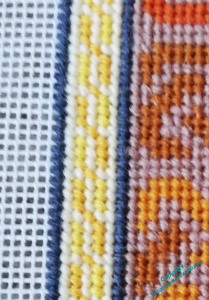
I hadn’t quite recovered from tyeing myself in knots when I did the next narrow band. This was intended to be a chain link pattern, but I ended up with something else – what, I’m not quite sure!
The next Episode of #SlowTVStitchery is now live – remembering the agony of unpicking Akhenaten’s seat, while considering the question of the right style of detail to add to a design, with particular reference to the Christmas Angel.
Reporting on the Christmas Angel
If you have been watching the videos, you will know how the Angel has been going, but it’s sometimes helpful to see things straight-on, which my videoing set up doesn’t achieve.
I got to the bottom edge and felt very pleased with myself – only to discover that not only was the top edge not done, but working the pattern in the other direction is slightly trickier than you might expect! It only slowed me down by a week or so, so not too serious… The next decision was about how to edge the angel, which edges, and with what. I’ve gone for a mixture of threads and cords so far, making different choices depending upon the sort of edge and how emphatic I want it to be.
Yes, I know I haven’t done the hair yet! I’m still not sure how, and I want all the gold done first, so I know what the hair has to deal with.
At the moment I have tacking stitches in place for the wing patterns, while I stare and try to decide which I want to do.
Any suggestions?
And while we all consider that, I can report that Episode 47 of SlowTV Stitchery is now live, in which we return to the Amarna Family Group to add some details, recollect the working of the Colossus of Akhenaten, and discuss needle choice and other technical aspects of the additional details.
More Stash Busting
In the clearest demonstration yet – at least in embroidery terms – that we are in the End Times, I have embarked on some stash busting counted tent stitch.
I rather enjoyed working on the Stash Busting Footstool, and there was a bit of canvas left on the frame when I’d made it, so I reattached the cut end, rifled through what was left of the tapestry wool, and started to play.
Since I don’t know how far my wools will stretch, my sole “design” is to take the idea of making a fabric from ornamental ribbons, alternating broad and narrow.
This vine pattern is based on one in “Needlepoint” from Ebury Press.
The next two “ribbons” I made up as I went along – one narrow, light pattern in two shades of yellow, and another broad one, this one distinctly made-up-as-I-went-along. It was very vaguely inspired by another in “Needlepoint”, which in turn claimed to be inspired by a Persian pattern. I have my doubts, but in any case, even when I tried to have a sensible pattern of spacing, I ended up with something of a mishmash.
You may have noticed that the “neutral” in the two broad stripes is not the same colour. I’m going to try to alternate these as backgrounds, unless and until I start to need to blend them together to fill the space.
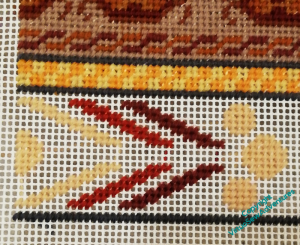
The next, narrow, band, is a chequerboard.
I like the stripe part of this next pattern, but after working the baubles, I looked again and decided that they weren’t quite working. I was trying for a mix of shapes, a bit of variety, and something to change the spacing of the stripes, but not this!
And while you assimilate the shock of me happily doing counted work – Episode 44 of Slow TV Stitchery is now live. In which we discuss the EES as an early crowd-funded organisation, my ambitions to hold a Dreams of Amarna exhibition, and whether “medieval muddle” is an idea purely from 19th Century northern Europe.
The Stash Busting Footstool, 4
After a bit of thought and discussion, my mother suggested that for the last two panels, I should consider doing the same as on the far side of the central panel, but in a different set of colours. I had wanted to lighten the colours as they came away from the central panel, so that’s the scheme I used to pick the colours.
That, and making sure that I thought I would have enough of each colour to do both panels!
I then made things slightly harder for myself by deciding to line up the stripes across the central panels, but it was definitely worth doing. As I’ve said before, when upcycling, mending, or dealing with slightly not-entirely-planned projects, the whole secret is to make it all look deliberately planned – that’s why my mending tends to be embellished in a variety of ways.
Here is the finished canvaswork.
Actually, it isn’t. When I took it off the frame and took it to meet the footstool it’s intended for, I found it was an inch too short, in spite of what I believed to have been some careful measuring.
Clearly not careful enough!
I’m going to add half an inch to each end, and then consider the next step!
In other news, Episode 42 of Slow TV Stitchery is now live. In which I think I may have got to grips with the pattern, consider the adventures of Sir John de Mandeville, and consider the question of Music To Stitch To…
Stash Busting Canvaswork Footstool – 3
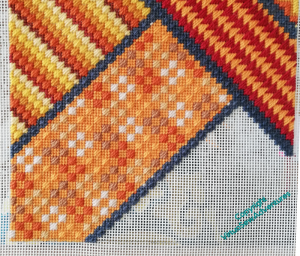
The notion that was guiding me – apart from stash busting – was of the colours getting lighter as they spiral out from the central point on either side of the central bar. So I picked more colours that I had enough of (see the constant balancing act I was involved in here?), and this time, stitch patterns which were squarish, rather than stripy. This is Checquer Stitch, and somehow by the time I’d finished the alternation of the colours, I ended up with something that rather reminded me of a Welsh Tapestry blanket. I’m happy with that – I was born in Wales, after all!
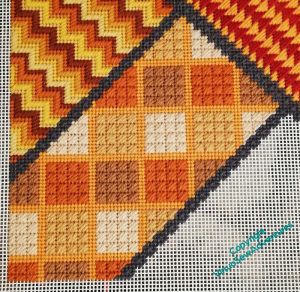
The balancing panel is even squarer. I suppose it is another variant – rather as with the Moorish Stitch Variation, I’ve moved all the tent stitches to the edges to form a grid. I think it still has enough family resemblence both to the original stitch and to the “Welsh Tapestry” version to balance them.
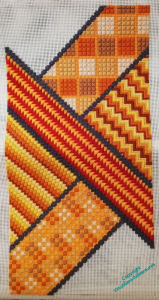
So here is stage two completed.
I think the balance and harmony I’m trying to create really are still there, but I feel as though I’ve rather shot my bolt. I’ve mislaid my canvaswork books and I can’t think of another suitable pair of diagonal stitches to use.
However, the first thing to do is to find a suitable set of colours. Onward, ever onward!
In the meantime, Epsiode 41 of SlowTV Stitchery is now live. A fairly quiet episode, this, which nonetheless discusses musical deceleration and taking refuge in learning things, while also anticipating the enjoyment of a Holiday Project.
Stash Busting Canvaswork Footstool -2
As this is a strictly stash-busting exercise, and I wanted to balance the colours across the central bar, I started by finding the colours I had two skeins of, and putting them in order of intensity. This is Jacquard Stitch, but where the classical colour patterning is one colour for the broad stripes and another for the tent stitch, here I have simply cycled through the colours, so that each colour has a chance at both stripes.
On the other side of the central bar, the same colours, but this time in a variant of Moorish Stitch. I felt the same pattern of colours would be a bit too obvious, so this is a simple stripe, and where classically there is a row of tent stitch between each row of squares, this time I simply used a row of tent stitch in the darkest shade to “reset” the pattern.
And here is the result.
The stripes run the same way and balance each other very nicely, I think. I like the way the alternations in the Jacquard Stitch seem so very active, while the Moorish Stitch section is quieter and creates a simple shaded effect, rather like a row of cylinders side by side.
Episode 39 of SlowTV Stitchery is now live, on the delights of careering through history, the plethora of Mathildas in post-Conquest English royal circles, and giving some consideration of the eventual display of the piece.

